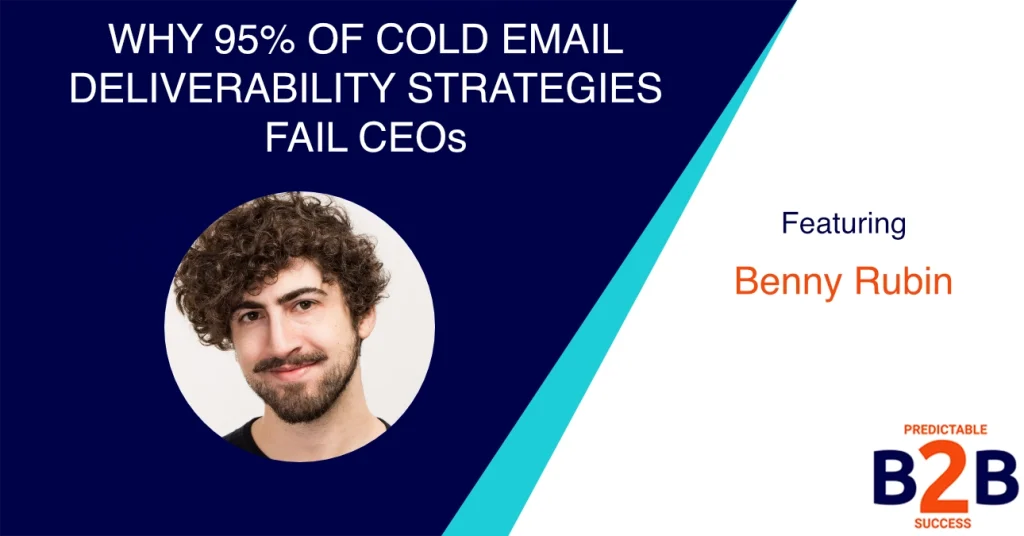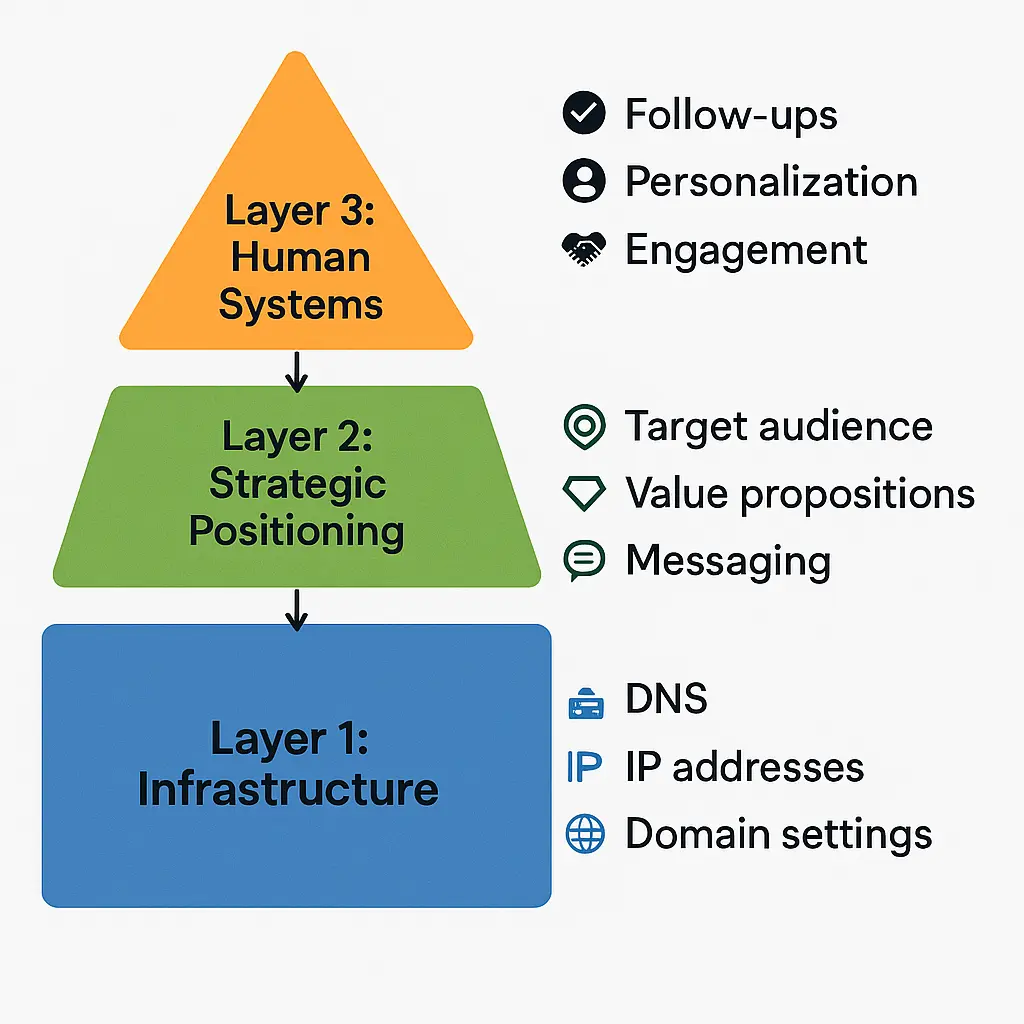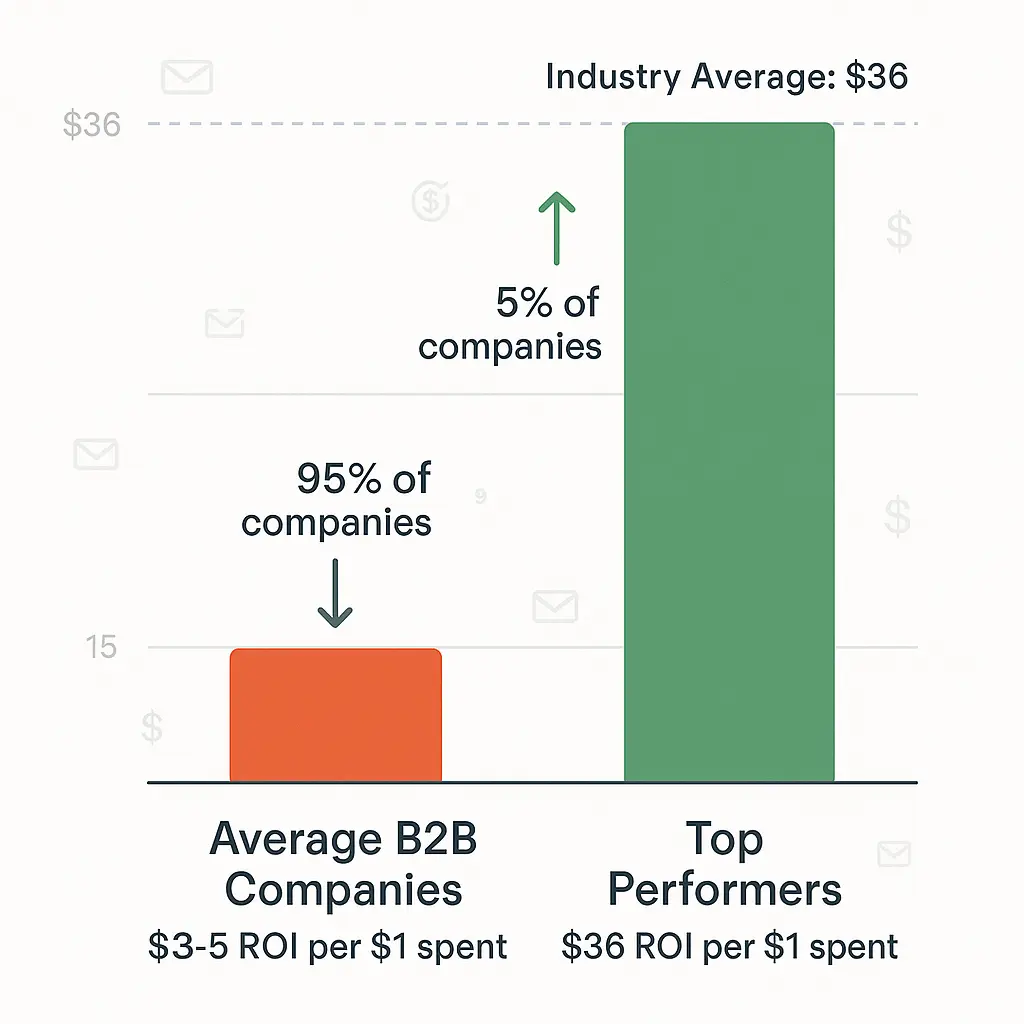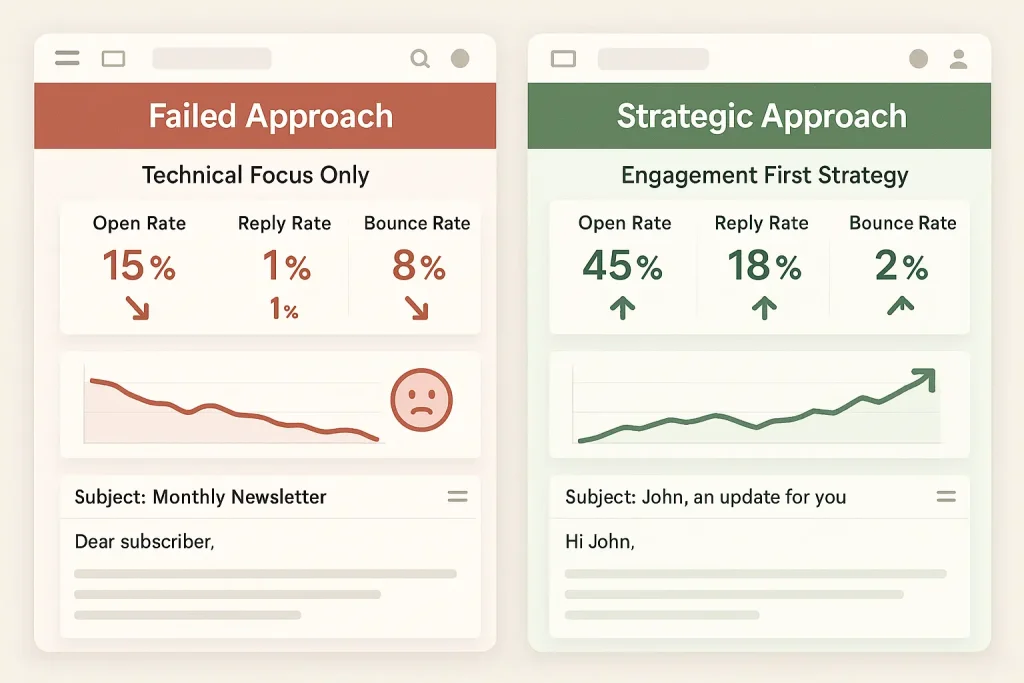
The CEO’s Guide to Cold Email Deliverability That Works
Bottom Line Up Front: Most CEOs waste months chasing tactical deliverability fixes while ignoring the strategic foundation that drives revenue. 95% of cold emails fail because leaders focus on symptoms instead of systems.
Here’s what no one tells you about cold email deliverability: your technical setup is probably fine.
The real problem? You’re solving the wrong problem entirely.
The Expensive Myth That’s Killing Your Pipeline
Every week, I watch funded B2B tech CEOs burn through runway chasing deliverability ghosts. They’ll spend five weeks researching SPF records while their competition books meetings with the same prospects.
Benny Rubin, founder of Senders, puts it perfectly:
“We talk to companies. You will not believe it. They’ve gone on two week, three week, four week, five week rabbit holes reading everything under the sun. They’re all gung ho about becoming email deliverability experts. And then one look of their DNS records and go ‘Look. You have two SPF records. That means that potentially 50% of your emails are going to fail.”
The conventional wisdom says, “Fix your technical setup first, then worry about messaging.”
I’m calling BS.
Meet the Expert: Why Benny Rubin’s Perspective Matters
Before diving deeper into deliverability strategy, let me introduce the expert whose insights shaped this contrarian approach.

Benny Rubin isn’t your typical email marketing guru posting theoretical advice on LinkedIn. As founder and CEO of Senders, he’s a three-time entrepreneur with a unique vantage point: his team currently manages cold email campaigns for 79+ companies simultaneously.
This isn’t someone who built one successful campaign and now teaches it. Benny’s background spans from music school dropout to B2B sales veteran, having accidentally built multiple businesses in the social media and influencer marketing space before discovering cold email’s potential in 2016.
What makes his perspective invaluable? Scale and pattern recognition. While most “experts” base their advice on single-company experiences, Benny sees deliverability patterns across industries, company sizes, and growth stages on a daily basis. His team has overseen cold emails generating hundreds of millions in pipeline for companies ranging from startups to enterprises like Starbucks, Visa, and Coca-Cola.
His journey from music to email deliverability taught him something crucial: technical perfection matters less than understanding human psychology at scale. It’s this perspective that challenges conventional deliverability wisdom.
Watch the Full Expert Interview
Want to hear Benny’s unfiltered insights directly? I sat down with him for an in-depth conversation about what drives cold email success at scale. In this episode, he reveals why most deliverability advice misses the mark and shares specific strategies his team uses across 79+ companies.
Key topics covered in the full interview:
- Why technical obsession hurts ROI
- The “unit economics mindset” that transforms cold email strategy
- Real examples of companies getting 20%+ reply rates
- How to build cold email systems that scale without burning domains
- The strategic mistakes that kill deliverability (hint: it’s not DNS records)
This conversation goes deeper than most surface-level deliverability content you’ll find online. Benny doesn’t just share tactics—he explains the strategic thinking behind sustainable cold email programs that drive revenue.
What 79 Companies Taught Us About Real Deliverability
Benny’s team manages cold email for 79+ companies simultaneously, giving him a perspective most “experts” lack. While solopreneurs write LinkedIn posts about their single campaign, they’re seeing patterns across industries, company sizes, and growth stages.
His contrarian insight changed how I approach email marketing strategy for my B2B tech clients: engagement trumps everything else.
“You have emails that get sent out to the tune of million, maybe even hundreds of millions that no one ever engages with. But somehow most of those emails are still delivered,” Benny explains. Think about it—those “If this is you, don’t do anything” security emails from your bank have zero engagement, yet they consistently hit inboxes.
The Three-Layer Deliverability Stack That Actually Works
Based on my experience creating content that converts for seed-to-Series-C startups, here’s what separates the 5% who succeed:

Layer 1: Infrastructure (The Foundation You Can’t Skip)
Yes, technical setup matters. But it’s table stakes, not competitive advantage.
The fundamentals are non-negotiable deliverability requirements:
- Domain health: SPF, DKIM, and DMARC records must be configured appropriately
- IP reputation: Dedicated IPs for volume senders, shared for smaller campaigns
- DNS monitoring: Because “your SPF’s missing” is usually the real culprit behind mysterious deliverability drops
But here’s where most CEOs go wrong: they obsess over this layer while ignoring layers 2 and 3.
Layer 2: Strategic Positioning (Where Money Gets Made)
This is where B2B tech leaders gain an unfair advantage.
Smart companies use cold email to “fatten the middle of their funnel” rather than going straight for demos. One of Benny’s clients invites prospects to their robust community instead of pitching their product. Another does invitation-only roundtables.
The breakthrough: you’re not selling your product in cold emails—you’re selling proximity to value.
Layer 3: Human Systems (The Multiplier Effect)
55% of replies come from follow-up emails, yet 70% of reps stop after one email.
This isn’t about persistence—it’s about building systems that scale human judgment.
Why Technical Obsession Destroys ROI
From my work helping B2B companies build authority with nonprofits, SaaS companies, and digital agencies, I’ve seen this pattern repeatedly: teams that focus on technical optimization first burn cash faster than those who nail positioning.
The average cold email conversion rate is just 0.2% (1 deal per 500 emails). 50% of campaigns have reply rates under 10%.
But the top performers? The best 25% of campaigns achieve 20%+ reply rates.
The difference isn’t their technical setup—it’s their strategic approach.
The CEO’s Cold Email Triage Protocol
When deliverability problems hit (and they will), use this framework I’ve developed for C-suite leaders:
Week 1: Strategic Audit
- Are you targeting the right decision-makers?
- Does your value proposition address actual pain points?
- Can prospects immediately understand your offer?
Week 2: Message Testing
- Test different value propositions beyond your core product
- Try community invitations or content offers
- Measure engagement, not just open rates
Week 3: Technical Validation
- Check authentication records (SPF, DKIM, DMARC)
- Monitor bounce rates (<5% threshold)
- Verify domain reputation
Notice the order? Strategy first, tactics second.
The Revenue Impact of Getting This Right
Companies using A/B testing see 82% higher ROI compared to those that never test. But most CEOs A/B test subject lines instead of testing fundamental positioning.
Only 5% of senders personalize every email, but they get 2-3x better results.
B2B Cold Email Performance Benchmarks: What Success Really Looks Like
| Metric | Average Performance | Top 25% Performance | Best Practice Focus |
|---|---|---|---|
| Reply Rate | 1-7% | 20%+ | Strategic positioning & engagement |
| Open Rate | 23.9% | 40%+ | Deliverability monitoring |
| Conversion Rate | 0.2% | 2-5% | Value proposition alignment |
| Bounce Rate | Varies | <5% | List hygiene & email verification |
| Follow-up Response | 55% of total replies | 70%+ | Systematic follow-up sequences |
Source: Analysis of 65+ million cold emails across multiple studies

Here’s what that looks like in revenue terms: if your current cold email program generates $100K in pipeline, fixing your strategic approach (not just technical issues) could unlock $200-300K additional pipeline.
For a Series A company raising on $2M ARR, that’s the difference between hitting your next milestone and missing it entirely.
Key Insight for Sales Development Teams: “Your email deliverability problem is actually a positioning problem. Fix strategy first, tactics second.” — This fundamental shift in thinking separates successful outbound sales strategies from failed ones.
What Modern ESP Algorithms Actually Reward
Email deliverability is scored based on the trustworthiness of your behavior with your prospects. Google, Outlook, and Yahoo each score you differently based on recipient behavior.
The secret? Companies with very healthy, steady, interested replies can email “essentially the same thing for years” without deliverability issues.
That’s right—consistent engagement beats technical optimization every time.
Sales Automation Reality Check: “Companies obsessing over SPF records while ignoring engagement are optimizing for the wrong metrics. Email service providers reward human connection, not perfect DNS configurations.”

The Anti-Deliverability Approach That Works
Instead of chasing perfect technical scores, focus on what creates engagement:
1. Radical Relevance Research prospects beyond basic firmographics. What challenges are they discussing publicly? What goals are they announcing?
2. Value-First Positioning
Successful companies don’t email people to invite them to demos—they invite them to valuable experiences that happen to showcase their expertise.
3. Strategic Follow-Up The optimal number of follow-ups is 3, but vary your approach each time.
Tools That Scale Human Judgment
For B2B tech companies serious about cold email ROI:
Infrastructure Layer:
- Custom domain setup for cold outreach (protect your main domain)
- Email warm-up services (automated reputation building)
- Authentication monitoring (prevent configuration drift)
- Marketing qualified lead (MQL) tracking systems
Strategic Layer:
- Prospect research workflows (AI-enhanced, but human-verified)
- Message testing frameworks (beyond basic A/B tests)
- Content strategy alignment (focus on replies, not opens)
- Sales development representative (SDR) productivity tools
Lead Generation & Automation:
- CRM integration for pipeline tracking
- Outbound sales sequence management
- Email engagement analytics
- Conversion rate optimization tools
B2B Email Marketing Truth: “The best cold email campaigns feel personal at scale. Technology should amplify human insight, not replace it.”
The 90-Day CEO Implementation Plan

Month 1: Foundation Reset & Strategy Audit
- Audit current cold email strategy (not just technical setup)
- Identify three value propositions beyond your core product
- Test engagement-focused messaging
- Analyze email engagement rates and bounce rates
- Review sales pipeline optimization opportunities
Month 2: System Optimization & Sales Automation
- Implement proper technical infrastructure
- Build prospect research workflows
- Create strategic follow-up sequences
- Set up email authentication protocols (SPF, DKIM, DMARC)
- Establish lead generation campaigns
Month 3: Scale and Measure Performance
- Expand successful campaign elements
- Optimize based on engagement data
- Build repeatable systems for consistent results
- Track marketing qualified leads (MQLs) and conversion rates
- Refine outbound sales strategy
Why This Matters for Funded Startups
Every month you spend chasing technical deliverability fixes is a month your competition gains market share through better sales development and lead generation strategies.
The companies “that are really succeeding with [cold email] don’t actually talk about it that much because it’s a steady channel that’s working fine”.
They’ve moved past deliverability obsession to strategic execution that drives revenue growth and customer acquisition.
Startup Growth Insight: “While your competitors debug DNS records, smart companies are building systematic outbound sales processes that scale with their growth stage.”
The Uncomfortable Truth About Cold Email ROI
The average ROI for email marketing is $36 for every $1 spent, but most B2B tech companies see closer to $3-5 per dollar because they’re solving the wrong problems.
The 5% who get this right aren’t necessarily better at technical setup—they’re better at understanding what creates human engagement at scale.
Your Next Move
If you’re a CEO watching your cold email program underperform while burning budget on technical fixes, consider this:
What if your deliverability problem is actually a positioning problem?
The companies I work with in my digital PR and content creation services see consistent results not because they’ve mastered DNS records, but because they’ve mastered human psychology at scale.
As Benny puts it: “If this is the big struggle of your winter… we can end the rabbit hole.”
Stop chasing technical perfection. Start building systems that create human connections.
Your pipeline—and your runway—will thank you.
Frequently Asked Questions
Q: What’s the most common cold email deliverability mistake CEOs make? A: Focusing on technical fixes (SPF records, DNS settings) before addressing strategic positioning. 95% of deliverability issues stem from poor engagement, not technical problems.
Q: What’s a good cold email reply rate for B2B companies? A: The average reply rate is 1-7%, but top performers achieve 20%+ reply rates. Anything above 10% is considered good performance for outbound sales campaigns.
Q: How many follow-up emails should I send in my sales automation sequence? A: The optimal number is 3 follow-ups. 55% of replies come from follow-up emails, yet 70% of sales development representatives stop after the first email.
Q: Should I use separate domains for cold email and lead generation? A: Yes. Use secondary domains for cold outreach to protect your primary domain’s reputation. This is a fundamental best practice for scaling B2B email marketing programs.
Q: What’s more important for email engagement: open rates or reply rates? A: Reply rates. Open rates primarily indicate deliverability, while reply rates show message effectiveness and engagement quality with your target audience.
Q: How do I know if my cold email deliverability is good? A: Monitor bounce rates (keep under 5%), reply rates (aim for 10%+), and inbox placement. If open rates consistently fall below 40%, you likely have deliverability issues affecting your sales pipeline.
Q: What email authentication protocols should I implement? A: Set up SPF, DKIM, and DMARC records properly. These email service provider requirements help establish sender reputation and improve deliverability rates.
Ready to move beyond deliverability tactics to strategic cold email systems? I help B2B tech leaders build educational email courses and LinkedIn content strategies that generate a consistent pipeline without technical headaches. Connect with me to explore how strategic content can transform your outbound efforts.
Some areas we explore in this episode include:
Listen to the episode.
Related links and resources
- Check out Senders
- Learn from Ed Forteau – How to Drive Growth With Email Deliverability And Client Transition Strategies
- Learn from Yurii Veremchuk – The Best Practices For Cold Outreach to Scale Your Business
- Check out the article – How Nathan Barry Grew ConvertKit From Zero to $125,000+ in Monthly Recurring Revenue (Part 2)
- Check out the article – How To Implement Lead Generation Automation For Explosive Growth
- Check out the article – Mastering Outbound Prospecting: The Ultimate Guide to Driving Revenue Growth in 2025
Connect with Benny Rubin
Subscribe to & Review the Predictable B2B Success Podcast
Thanks for tuning into this week’s Predictable B2B Podcast episode! If the information in our interviews has helped your business journey, please head over to Apple Podcasts, subscribe to the show, and leave us an honest review.
Your reviews and feedback will not only help me continue to deliver great, helpful content but also help me reach even more amazing founders and executives like you!

